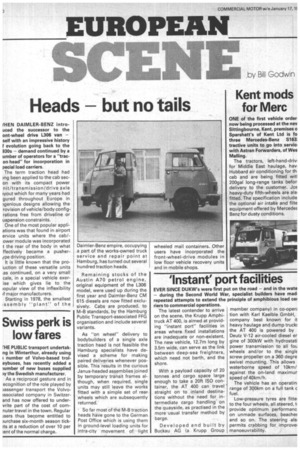Heads but no tails
Page 72

If you've noticed an error in this article please click here to report it so we can fix it.
(HEN DAIMLER-BENZ introuced the successor to the ont-wheel drive L306 van — self with an impressive history F evolution going back to the 930s — demand continued by a umber of operators for a "tracon head" for incorporation in pecial load carriers.
The term traction head had mg been applied to the cab secon with its compact power nit/transmission/drive axle iyout which for many years had gured throughout Europe in Igenious designs allowing the rovision of vehicle/body configrations free from driveline or uspension constraints.
One of the most popular appliations was that found in airport ervice units where the cab/ower module was incorporated t the rear of the body in what ffectively became a pusheripe driving position.
It is little known that the prouction of these versatile units as continued, on a very small cale, in a special vehicle exerise which gives lie to the lopular view of the inflexibility if major manufacturers.
Starting in 1978, the smallest ssembly "plant" of the Daimler-Benz empire, occupying a part of the works-owned truck service and repair point at Hamburg, has turned out several hundred traction heads.
Remaining stocks of the Austin A70 petrol engine, original equipment of the L306 model, were used up during the first year and Daimler-Benz CM 615 diesels are now fitted exclusively. Cabs are produced, to M-B standards, by the Hamburg Public Transport-associated FFG organisation and include several variants.
As "on wheel" delivery to bodybuilders of a single axle traction head is not feasible the Hamburg specialists have devised a scheme for making paired deliveries whenever possible. This results in the curious Janus-headed assemblies joined by temporary transit frames although, when required, single units may still leave the works fitted with a simple set of rear wheels which are subsequently returned.
So far most of the M-B traction heads have gone to the German Post Office which is using them in ground-level loading units for intra-city movement of light wheeled mail containers. Other users have incorporated the front-wheel-drive modules in low floor vehicle recovery units and in mobile shops.












































































































